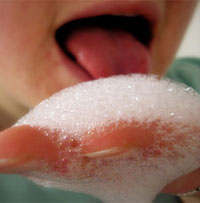My pediatrician swears by those gel hand sanitizers for lowering the risk of my family getting sick during cold and flu season.
My pediatrician swears by those gel hand sanitizers for lowering the risk of my family getting sick during cold and flu season. But I’ve also heard that these products can be dangerous to kids if ingested. Are there any safer alternatives that work just as well?
—Jason Blalock, Oakland, CA
A 2005 study by the Children’s Hospital in Boston compared illness rates across a study group of 292 families—half of them got hand sanitizers while the other half were given literature advising them of the benefits of frequent hand washing. The findings revealed that those families who used hand sanitizers experienced a 59 percent reduction in gastrointestinal illnesses and that the increased use of sanitizers correlated to a decreased spread of contagions in general.

Although gel hand sanitizers have proven in tests to reduce gastrointestinal illnesses and the spread of contagions compared to ordinary soap and water, their high alcohol content can be poisonous to children who ingest them.© Living is Easy with Eyes Closed
Another study conducted at Colorado State University yielded similar conclusions, that alcohol-based hand sanitizers were as much as twice as effective as either regular soap or antibacterial soap at reducing germs on human hands. A Purdue University study, however, concluded that while alcohol-based hand sanitizers may kill more germs than plain or triclosan-based soaps, they do not prevent more infections that make people sick. Instead they may kill the human body’s own beneficial bacteria by stripping the skin of its outer layer of oil.
The down side of the gel/alcohol products is their danger as poison, especially for young children who may ingest the gel by licking it off their hands or eating it directly out of dispensers. Purell and Germ-X, two of the leading brands, each contain 62 percent ethyl alcohol. While this alcohol is what gives the products their germ-busting power, it also puts kids at risk of alcohol poisoning. A few squirts of the hand sanitizer—which is equivalent to124 proof booze—is enough to make a kid’s blood alcohol level .10, which is the equivalent of being legally drunk in most states.
So what’s a concerned parent to do? Unfortunately, the so-called greener alternatives out there aren’t safe to swallow either. EO Hand Sanitizer, for example, though it uses organic lavender oil also contains alcohol to sanitize the skin surface, and would also be considered poison if a large enough amount was ingested. Similarly greener (but still not safe to eat) products are available from Avant and All Terrain.
For now, soap and warm water—and constant nagging of your kids to wash their hands—may be the safest way to sanitize. Also, make sure that any hand sanitizer dispensers you may still use are kept out of the reach of little hands.
But who knows how we”ll be sanitizing our hands in the future. Researchers at Arizona State University have found that certain types of natural clays pulled right from the ground are highly effective at killing bacteria. One type of green clay has been shown to do a number on E. coli, salmonella, staph and other bacteria known to make people sick. But the research is still in its infancy, so don’t expect to see moms pulling jars of clay out of their purses anytime soon.
CONTACTS: EO Products; OrganicBeautySource.com; MotherNature.com

